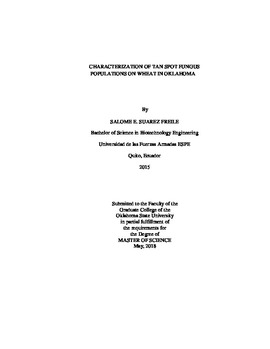| dc.contributor.advisor | Marek, Stephen M. | |
| dc.contributor.author | Suarez Freile, Salome Estefania | |
| dc.date.accessioned | 2019-05-08T18:36:49Z | |
| dc.date.available | 2019-05-08T18:36:49Z | |
| dc.date.issued | 2018-05-01 | |
| dc.identifier.uri | https://hdl.handle.net/11244/319621 | |
| dc.description.abstract | Wheat is the third most important crop in terms of planted land, production and value in the US. In Oklahoma, changes in cultural practices such as reduced tillage or no-till has contributed to a higher incidence of fungal leaf spot diseases. Tan spot caused by Pyrenophora tritici-repentis (PTR) is a significant wheat leaf spot disease capable of reducing yields in no-till systems. To evaluate the significance of PTR in Oklahoma, a culture-based, molecular identification approach was used to isolate and identify fungi from symptomatic leaves collected from 13 no-till winter wheat fields across Oklahoma during spring in 2016 and 2017. Cultures were morphologically identified as 'PTR-like' or 'pycnidial fungi'. Of 755 cultures isolated, 565 (75%) were PTR-like and 190 (25%) were pycnidial fungi. Molecular identification of 477 single-spore PTR-like isolates using PTR-specific PCR primers indicated that 311 (65%) of these were PTR in 2016, and from 139 PTR-like isolates 78 (56%) were PTR in 2017. Next, seven simple sequence repeat (SSR) markers were used to assess the genetic diversity of two subsets of PTR populations in Oklahoma. First, a subset of 180 PTR isolates from 10 fields in 2016 were found to show low genetic differentiation among field populations. And second, PTR isolates collected from four fields in 2016 and 2017 were found to show no genetic grouping of individuals according to geographic origin or year of sampling. Analysis of the genetic structure of PTR in 2016 and 2016-2017 suggests significant local distribution of the isolates, extensive long distance movement of the inoculum and frequent recombination. To evaluate the incidence of genes for the cultivar-specific toxins, ToxA and ToxB, among PTR isolates, specific primers were used. Of 389 isolates tested from 2016 and 2017, 373 (95%) were positive for ToxA, while none of the PTR isolates tested positive for ToxB. Phenotypic race characterization was performed using five PTR isolates on five differentials cultivars of wheat and found that four of the isolates were race 1 and the remaining one could not be classified as one of the eight known races. In summary, tan spot is the predominant leaf spot disease associated with no-till wheat in Oklahoma, populations of the tan spot fungus, PTR, undergo frequent genetic recombination and migration, and most PTR isolates appear to carry ToxA and can be classified as race 1. | |
| dc.format | application/pdf | |
| dc.language | en_US | |
| dc.rights | Copyright is held by the author who has granted the Oklahoma State University Library the non-exclusive right to share this material in its institutional repository. Contact Digital Library Services at lib-dls@okstate.edu or 405-744-9161 for the permission policy on the use, reproduction or distribution of this material. | |
| dc.title | Characterization of Tan Spot Fungus Populations on Wheat in Oklahoma | |
| dc.contributor.committeeMember | Hunger, Robert M. | |
| dc.contributor.committeeMember | Garzon, Carla D. | |
| osu.filename | Suarez_okstate_0664M_15742.pdf | |
| osu.accesstype | Open Access | |
| dc.description.department | Entomology and Plant Pathology | |
| dc.type.genre | Thesis | |
| dc.type.material | Text | |
